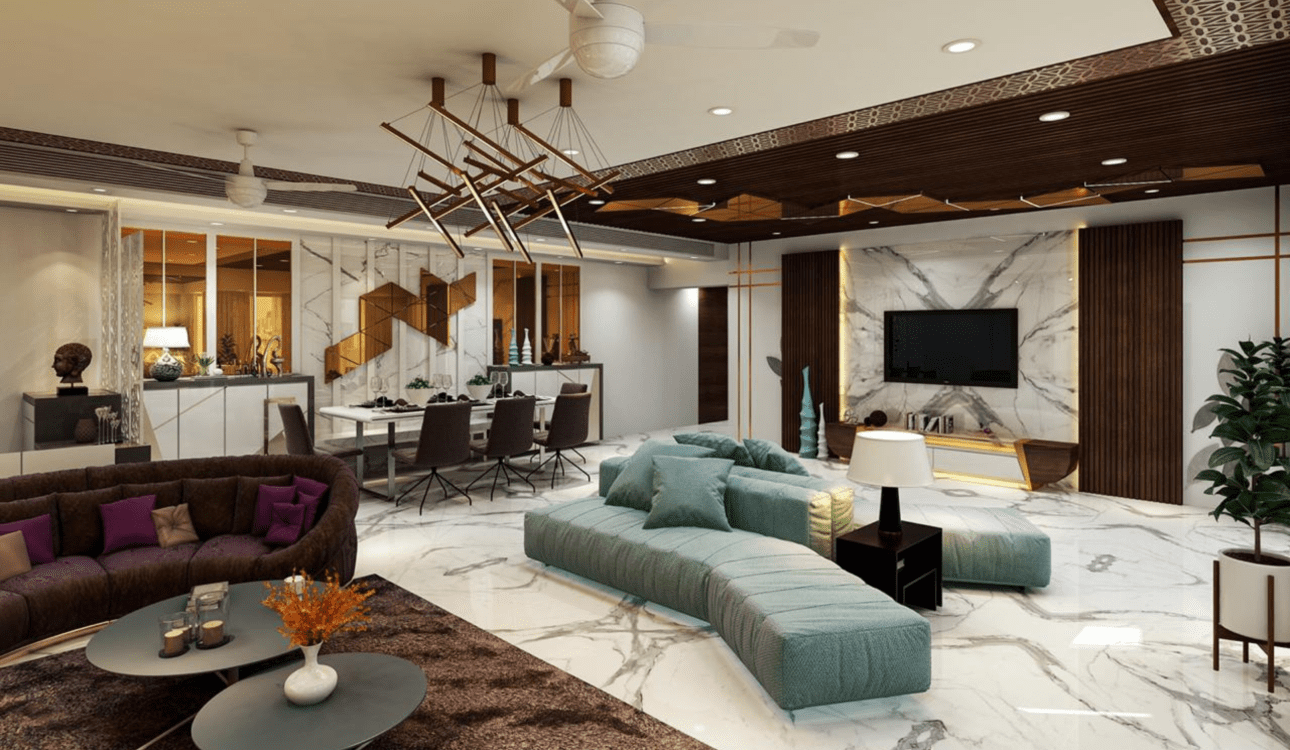WHAT IS HOME INTERIOR DESIGN?
Residential interior design is a comprehensive practice that revolves around planning and enhancing living spaces within homes. Whether it’s a house, apartment, condo, or any other residential property, interior design focuses on creating an environment that’s both functional and aesthetically pleasing. Here are 15 key aspects that define residential interior design
1. Space optimization
Space optimization in home interior design focuses on efficiently utilizing available space for both functionality and aesthetics. It involves strategies like smart furniture choices, creative storage solutions, and the use of light colors and mirrors to make spaces appear larger. The goal is to maximize the utility of each area, especially in smaller homes, while maintaining an appealing and comfortable environment.
2. Interior Aesthetics
Interior aesthetics in residential interior design concentrate on enhancing the visual appeal of living spaces. This involves careful selection of color schemes, materials, and decor elements to create a cohesive and visually pleasing environment that aligns with homeowners’ preferences and the desired atmosphere. It’s about making a space beautiful, comfortable, and reflective of the residents’ unique style.
3. Architectural Harmony
Architectural harmony in home interior design ensures a seamless connection between interior and exterior spaces, incorporating architectural elements that complement the overall design. It focuses on maintaining a consistent and aesthetically pleasing look throughout the home, creating a sense of unity and flow between the interior and the structural aspects of the property.
4. Material and finish selection
Material and finish selection in residential interior design involves choosing the right materials for surfaces such as flooring, walls. And cabinetry. This process aligns with the design concept and the homeowners’ preferences, ensuring a harmonious and visually appealing environment that complements the overall aesthetic of the living space.
5. Kitchen and bathroom expertise
Kitchen and bathroom expertise in home interior design focuses on creating functional and stylish layouts for these essential spaces. It includes selecting fixtures, cabinetry, and finishes that meet both the aesthetic and practical requirements, ensuring these areas are not only visually pleasing but also highly functional.
6. Illuminating Ambiance
Creating an illuminating ambiance in residential interior design involves carefully planning the lighting scheme to enhance both aesthetics and functionality. It ensures the right lighting for various activities and moods, contributing to a well-lit and welcoming living space that can adapt to different needs and atmospheres.
7. Custom furnishings
Custom furnishings in home interior design involve designing or sourcing furniture and fixtures that are tailor-made to fit the space and the homeowners’ unique style. These personalized pieces add a distinct touch to the living space, ensuring it’s not only functional but also a reflection of the residents’ preferences.
8. Project Coordination
Project coordination in residential interior design encompasses the management of the entire design process. This includes overseeing the implementation of the design plan, collaborating with contractors of the suppliers, and ensuring that the project runs smoothly from concept to execution , resulting in a successful transformation of the living space.
9. Budget management
Budget management involves assisting homeowners in setting budgets and providing cost estimates to ensure the project remains within financial constraints. This helps prevent overspending and ensures that the design project aligns with the allocated budget.
10. Color coordination
Color coordination is the art of selecting and harmonizing colors that resonate with homeowners’ preferences and create a pleasing and unified atmosphere within the living space. It involves choosing the right color palettes for walls, furnishings, and decor elements to achieve the desired aesthetic and ambiance.
11. Furniture selection
Furniture selection involves choosing furnishings that align with the design concept and the practical needs of the space. It ensures that the furniture complements the overall aesthetic while providing functionality and comfort in the living area.
12. Decor and Accessory Curation
Decor and accessory curation in residential interior design is the art of selecting decor elements and accessories such as artwork, rugs, and decorative items that enhance the overall ambiance of the living space. It adds the finishing touches that complete the design concept, making the space visually appealing and harmonious.
13. Home office optimization
Home office optimization in home interior design focuses on creating functional and stylish workspaces within homes. It ensures that the design incorporates efficient storage, ergonomic furniture, and technology integration to create a productive and organized home office environment that seamlessly blends with the overall residential space.
14. Sustainability and eco-friendly Design
Sustainability and eco-friendly design in residential interior design emphasize the use of environmentally conscious materials and practices. It involves selecting eco-friendly options for flooring, finishes, and furnishings, with a commitment to reducing the environmental impact of the design.
15. Staging for sale
Staging for sale in home interior design is the practice of preparing a property for sale by strategically arranging furniture, decor, and accessories to make it more appealing to potential buyers. It helps showcase the property’s full potential often leading to faster sales and potentially higher values.
Why Do You Need It?
Residential interior design is essential to transform a house into a comfortable and aesthetically pleasing home. It optimizes space, harmonizes colors, and ensures functionality making everyday life more enjoyable. Interior designers customize the space to match your style, integrate architectural elements, and manage the entire project efficiently.
Conclusion
Interior design is a science as well as an art at understanding clients behavior to create functional spaces within a building. Decoration is an art of furnishing or adorning a space with fashionable and beautiful items. To cut short the definition, “Interior designers may decorate, but decorators do not design”. If you’re looking to hire a residential interior designer in our services to help furnish your home, look no further than Home Makers Interior

